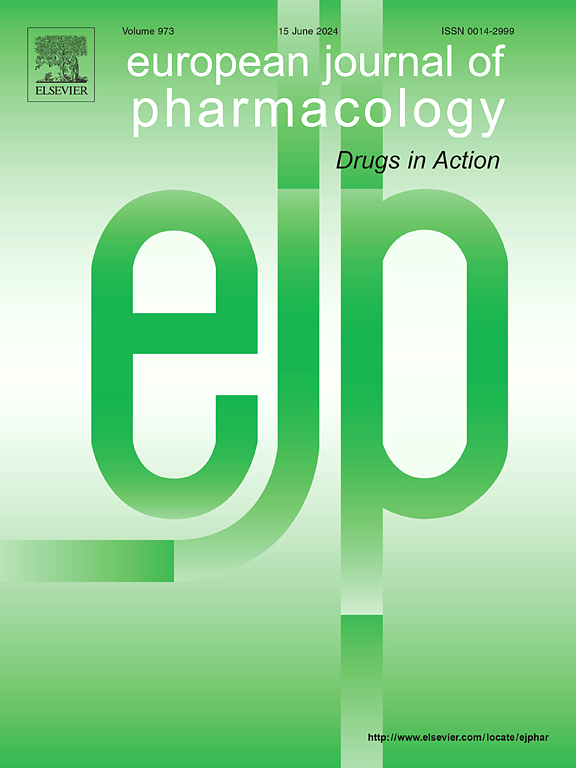3-苯并噻吩基-1-(3-羟基-3-苯基-3-丙基)-1-甲基硫脲的临床前和计算机研究:一种治疗抑郁和焦虑的有前途的药物。
IF 4.2
3区 医学
Q1 PHARMACOLOGY & PHARMACY
引用次数: 0
摘要
研究了合成的以麻黄碱为基础的硫脲衍生物3-苯并噻吩基-1-(3-羟基-3-苯基-3-丙基)-1-甲基硫脲的抗焦虑、抗抑郁、镇静/催眠和硅分子对接性能。在急性毒性试验中确定了该化合物在不同剂量下的安全性。结果表明,该化合物在所有小鼠研究中均具有显著的抗焦虑作用。在升高+迷宫(EPM)中,实验化合物显著增加了小鼠张开双臂的时间和进入时间。在光-暗(LD)箱试验中,药物增加了在光室中度过的时间。在孔板(HB)试验中,探孔率和饲养率显著增加。对于抗焦虑活性,20 mg/kg被确定为最佳剂量,而在硫喷妥诱导睡眠试验中,更高剂量(即40 mg/kg)可引起明显的镇静作用并延长睡眠时间。3-苯并噻唑基-1-(3-羟基-3-苯基-3-丙基)-1-甲基硫脲给药后,尾悬试验(TST)和强迫游泳试验(FST)的逃逸潜伏期增加,不动性显著降低。针对焦虑发病机制中涉及的多种蛋白靶点进行分子对接分析。分子对接、分子动力学(MD)模拟和自由能计算表明,配体与7VOD和2C65蛋白具有较高的结合亲和力和稳定性。综上所述,体内实验和分子模型研究表明,3-苯并噻吩基-1-(3-羟基-3-苯基-3-丙基)-1-甲基硫脲具有显著的抗焦虑和抗抑郁活性,同时具有很高的安全性。本文章由计算机程序翻译,如有差异,请以英文原文为准。
Preclinical and in silico studies of 3-benzothioyl-1-(3-hydroxy-3-phenyl-3-propyl)-1-methylthiourea: A promising agent for depression and anxiety
The study investigated the anxiolytic, antidepressant, sedative/hypnotic and in silico molecular docking properties of the synthetic ephedrine-based derivative of thiourea, 3-benzothioyl-1-(3-hydroxy-3-phenyl-3-propyl)-1-methylthiourea. Safety profile of the compound at various doses was determined in an acute toxicity test. Results showed significant anti-anxiety effects of the compound in all mice studies. In the elevated plus maze (EPM), the time spent and entries into open arms were significantly increased upon treatment with the test compound. In the light-dark (LD) box test the drug increased the time spent in the light compartment. In hole board (HB) assay, exploration of hole and rearing significantly increased. For anxiolytic activity, 20 mg/kg was determined to represent the optimal dose, while at a higher dose (i.e., 40 mg/kg), it caused significant sedation and increased sleep duration in thiopental-induced sleep test. Escape latency in the tail suspension test (TST) and in the forced swim test (FST) increased and immobility was significantly reduced upon 3-benzothioyl-1-(3-hydroxy-3-phenyl-3-propyl)-1-methylthiourea administration. The molecular docking analysis was performed against the various protein target involved in the pathogenesis of anxiety. The molecular docking, molecular dynamic (MD) simulation and free energy calculation showed high binding affinity and stability of ligand with the 7VOD and 2C65 protein. Taken together, it is concluded from both the in vivo assays and molecular modeling studies that 3-benzothioyl-1-(3-hydroxy-3-phenyl-3-propyl)-1-methylthiourea possesses significant anxiolytic and antidepressant activity in concomitant with a high safety profile.
求助全文
通过发布文献求助,成功后即可免费获取论文全文。
去求助
来源期刊
CiteScore
9.00
自引率
0.00%
发文量
572
审稿时长
34 days
期刊介绍:
The European Journal of Pharmacology publishes research papers covering all aspects of experimental pharmacology with focus on the mechanism of action of structurally identified compounds affecting biological systems.
The scope includes:
Behavioural pharmacology
Neuropharmacology and analgesia
Cardiovascular pharmacology
Pulmonary, gastrointestinal and urogenital pharmacology
Endocrine pharmacology
Immunopharmacology and inflammation
Molecular and cellular pharmacology
Regenerative pharmacology
Biologicals and biotherapeutics
Translational pharmacology
Nutriceutical pharmacology.

 求助内容:
求助内容: 应助结果提醒方式:
应助结果提醒方式:


